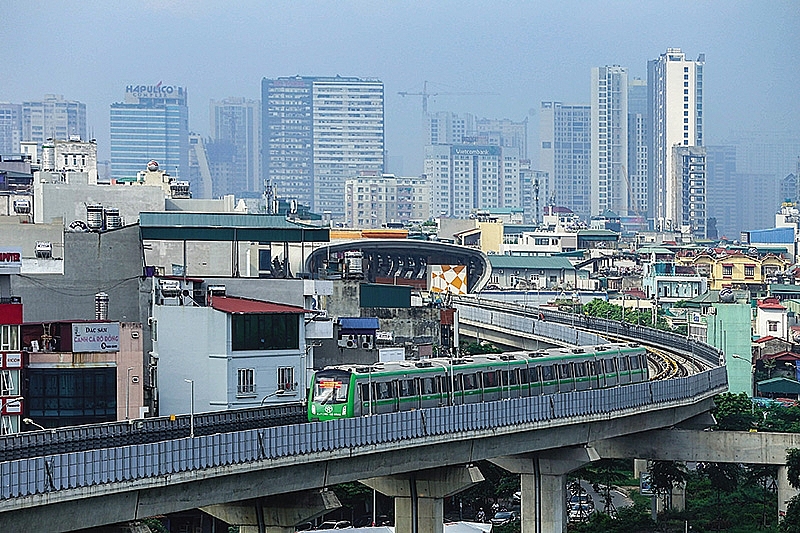New urban railway poses new challenges to Hanoi
 |
| The new Cat Linh-Hadong urban railway will alleviate Hanoi’s pressing traffic issues, Photo: Dung Minh |
READY FOR LAUNCH
After seven years of construction and a capital expansion to $868 million, five trains of the Cat Linh-Hadong urban railway project on September 20 began to perform a test run as the first step to soon begin operation.
According to the Ministry of Transport (MoT) – the project investor – the elevated urban railway will be officially put into commercial use at the end of 2018 and is hoped to replace many motorbikes and cars as local people’s main means of transportation.
“Hopefully in the near future the urban railways will help reduce the number of motorbikes as well as ease congestions along major routes,” said Nguyen Hong Truong, former Deputy Minister of Transport.
Over the past many years, the mounting population and the proliferation of motorbikes have caused heavy traffic jams across the country, especially in Hanoi and Ho Chi Minh City which are home to 7.6 million and more than 13 million people, respectively.
Thus, investment in urban railway and elevated railway lines has been identified as the best option to deal with the country’s poor traffic situation.
Under Decision No.3395/QD-BGTVT approved by the MoT in 2008, the 13 kilometre project officially began construction in October 2011 with an initial investment of $552.86 million, including $133.86 million from the Vietnamese government and $419 million borrowed from China. However, the total capital has been adjusted up to $868 million, with loans from China increasing by around $250 million to $669 million.
The Cat Linh-Hadong route will have 13 trains with four carriages each. The length of a train is 19 metres, with a height of 3.8m and width of 2.8m.
Once completed, each train will transport up to 1,200 passengers across 12 stations, including Cat Linh, La Thanh, Thai Ha, Lang, Thuong Dinh, Ring Road No.3, Phung Khoang, Van Quan, Hadong, La Khe, Van Khe, and Yen Nghia.
VIETNAM’S MAIN FORM OF TRANSPORT IN THE FUTURE
With the top speed of 80 kilometres per hour and the capacity of transporting 57,000 passengers per hour, the urban railway is expected to become the main means of transportation for Vietnamese people in the future.
“In urban transport, railway or elevated railway is an ace in the hole which helps to reduce traffic flows by 200,000-300,000 people during rush hours. It is the most optimal solution to deal with traffic jams in urban cities where dozen millions of people live,” said Nguyen Xuan Thuy, a transport expert.
In fact, urban railway is really popular in many countries. For instance, Thailand is currently famous for the $65 billion Bangkok Mass Transit System (BTS), which has turned the congested Bangkok from a few years ago into a modern city with smooth traffic. In the second quarter of 2016, the system served 61.7 million passengers and recorded $50 million in revenue, up 6 per cent on-year.
Taipei city of Taiwan (China) is also known for the $31.8 billion Metropolitan Rapid Transit (MRT), which serves 1.2 million passengers a day. Since it was put into operation in 1996, the system helps to reduced travel time to one-third as well as ease congestions in Taipei.
Burdened by mile- and hour-long traffic jams, Vietnam definitely cannot opt out of this trend.
“If we step back and look at the broader picture, developing urban railways is the only way to deal with the issue. Currently, there are no other forms of road transport that could meet the huge demand,” said Khuat Viet Hung, deputy director of the National Traffic Safety Committee.
Over the past few years, to reduce the huge number of motorbikes circulating on the roads of urban cities, the MoT has been promoting a variety of transport forms like buses and bus rapid transit (BRT), but people still stick to motorbikes, especially in Hanoi and Ho Chi Minh City.
Since their appearance in Vietnam in the 1960s, motorbikes have quickly become the most popular vehicles in the country, especially in Ho Chi Minh City. As the current road network consists of 85 per cent of alleys, motorbikes have been in high demand due to their compact size.
Thus, with the long-standing popularity of motorbikes, making locals take to the urban railway as their main form of transport will be a crucial challenge for the government as well as the MoT. Despite its undeniable advantages, it remains to be seen how locals will receive the new urban railways and how long it will take for them to take a shine to the new trains.
| Huy Hoang, 30, Cau Giay district, Hanoi
It takes 25 minutes to travel 13km, excluding the time to reach the station and then my actual destination. The new urban railway will not help me save time or money. As I have to travel quite a lot because of my job, motorbike is still the best option. Ngoc Lam, 28, Hadong district, Hanoi
It takes me 45-60 minutes to reach my workplace, which is 14km from my home, to avoid congestions. Day by day, I get stressed and wish I could use public transport instead of my motorbike. I cannot take the bus because it stops too often and still needs to fight its way through traffic. If the Cat Linh-Hadong route opens, I will try taking it for a month. If it is faster and cheaper, I will use it definitely. Vu Manh Cuong, 26, Hadong district, Hanoi
Since the route started construction, I was looking forward to the railway. Several days ago, I heard that the test run was carried out, so I hope it will be put into operation soon. With the traffic jams all across Hanoi, I have changed to BRT more than a year ago, but it is not much faster than buses during the rush hours. I am very annoyed because I have to spend three hours in traffic every day. Urban railway will be the best option as it will bypass congestions. However, I have to see about the price of the ticket. Hoang Thi Huan, 54, Dong Da district, Hanoi
The advantages of urban railway are obvious, but I will have to try it first. It is a fair distance between my house and the train station, so it may not be convenient enough. I think I will still travel by motorbike because I have to travel a lot every day. Nguyen Quynh, 25, Ba Dinh district, Hanoi
Looking at the pictures of the train on the news, I was completely taken by how modern and beautiful they look – just like the fast trains I was riding in Japan. The vehicles are not only environmentally friendly but also economical and clean. While outside the traffic is at a standstill, I might enjoy listening music and reading a book on the train instead. When the urban railway opens, people in Hadong district will not have to worry about traffic jams when going to the city centre. |
What the stars mean:
★ Poor ★ ★ Promising ★★★ Good ★★★★ Very good ★★★★★ Exceptional
Related Contents
Latest News
More News
- Vietnam's IFC to target global investment flows (December 21, 2025 | 18:00)
- Ha Tinh breaks ground on major Vingroup industrial and energy projects (December 19, 2025 | 18:24)
- EVN launches major power infrastructure projects nationwide (December 19, 2025 | 18:17)
- VAL inaugurates second production line to meet domestic animal feed demand (December 19, 2025 | 16:37)
- Sun Group pioneers urban tram system in Phu Quoc (December 19, 2025 | 15:00)
- Top 10 notable events of Vietnam’s industry and trade sector in 2025 (December 19, 2025 | 14:00)
- Seven major projects launched to drive Hanoi’s next growth phase (December 19, 2025 | 14:00)
- Rare, beautiful, sustainable: the mark of iconic real estate (December 19, 2025 | 08:00)
- Mondelez Kinh Do - a chapter of purpose-led leadership in Vietnam (December 18, 2025 | 09:44)
- VNPAY services receive the highest-level PCI DSS international security certificates for six consecutive years (December 17, 2025 | 23:47)






 Tag:
Tag:






















 Mobile Version
Mobile Version